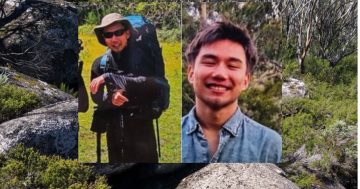
(From left): ACT Policing Rural Patrol Inspector Rod Anderson, two members from AFP Search and Rescue, including Sergeant Andrew Craig (right), and ACT Parks and Conservation Service executive branch manager Stephen Alegria. Photo: Travis Radford.
A coalition of groups has urged Canberra bushwalkers to be better prepared after five people were rescued during three separate search-and-rescue operations in the past month.
Members of the Australian Federal Police (AFP) Search and Rescue, ACT Parks and Conservation Service and ACT Policing Rural Patrol teams gathered in a representation of the number of organisations (excluding the State Emergency Service) and resources involved in the recent search-and-rescue operations in and around Namadgi National Park and the Brindabella Ranges.
All of the missing bushwalkers were found, with only minor injuries or mild hypothermia at worst, but emergency services warned the outcomes could have been much worse.
The groups did not ask bushwalkers to remain indoors during winter – within reason – but rather to be better prepared before setting out on the Canberra region’s scenic hikes.
1. Check the conditions (where you’re going, not where you are) and plan your trip
While it probably goes without saying that you should give the hike a miss if there’s terrible weather, AFP Search and Rescue Sergeant Andrew Craig said even during fine weather in Canberra, people should not take that at face value.
“Some people are not checking the temperatures up the mountains because they actually are colder in the mountains,” he explained.
“In winter, the temperatures drop below zero very, very quickly and it’s not just the air temperature, it’s actually the wind chill as well, because it’s quite windy up in the hills.”
One of the recent search-and-rescues involved people stranded on Mount Tidbinbilla after underestimating the duration of the hike and running out of daylight hours.
Hikers can use the Parks ACT website or visit the Namadgi National Park Visitor Centre in Naas Road at Tharwa to help choose and plan a trip that matches their ability.
2. Wear warm clothing and prepare for the worst with extra supplies
Bushwalkers were also advised to dress in warm clothing and bring additional clothes and wet-weather gear, extra food and water, a first aid kit and some form of shelter regardless of the length of the planned hike and whether they were planning to stay overnight. Sergeant Craig said this would help protect them from changing weather conditions or if they became injured or lost.
“If you’re not prepared with the right clothing, it can be a matter of hours, if not sooner, that you can actually become hypothermic and by the time we get there, it might be too late,” he said.
Sergeant Craig also explained there could be a “delay of many hours” between people asking for and getting help, because of the resources and time required to reach remote locations.
“Sometimes we actually have to go on foot, so if they’ve walked six or seven kilometres into the bush, then we’ll have to do the same and carry the equipment to get them out,” he said.
3. Make yourself easy to find in case of an emergency; i.e. don’t rely on your mobile phone
Some mobile phone applications can help emergency services find people, like ”What3words” and ”Emergency Plus”.
However, bushwalkers were urged not to rely on their mobile phones alone for navigation or as an emergency communication method, as they could lose battery power or reception.
While a portable charger can fix the first issue, ACT Parks and Conservation Service executive branch manager Stephen Alegria urged people to also tell friends or family where they are hiking and when they are due to return, use the logbooks at the trailheads of many walks and hire one of the Namadgi National Park Visitor Centre’s personal locator beacons for emergency use.
Bushwalkers were also reminded to remain where they were after activating the personal locator beacon or making contact with emergency services differently.
“If they’ve got the right gear, they’ve told someone where they’re going and they know how to navigate, then chances are they’ll be fine,” Mr Alegria said.
“We really love people getting out and about in our parks, as long as they’re safe.”


 Claire Mcdonnell’s enthusiasm for MTB is absolutely…
Claire Mcdonnell’s enthusiasm for MTB is absolutely… 










